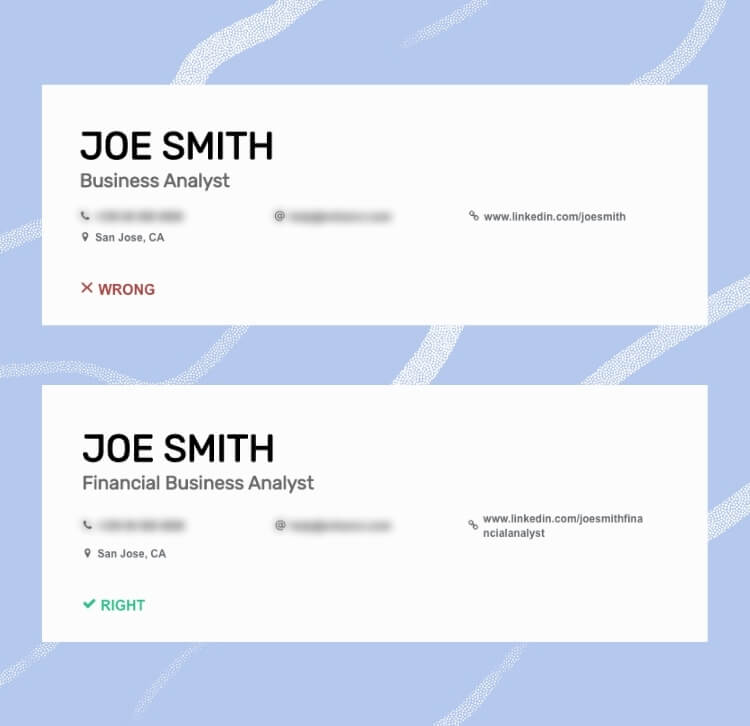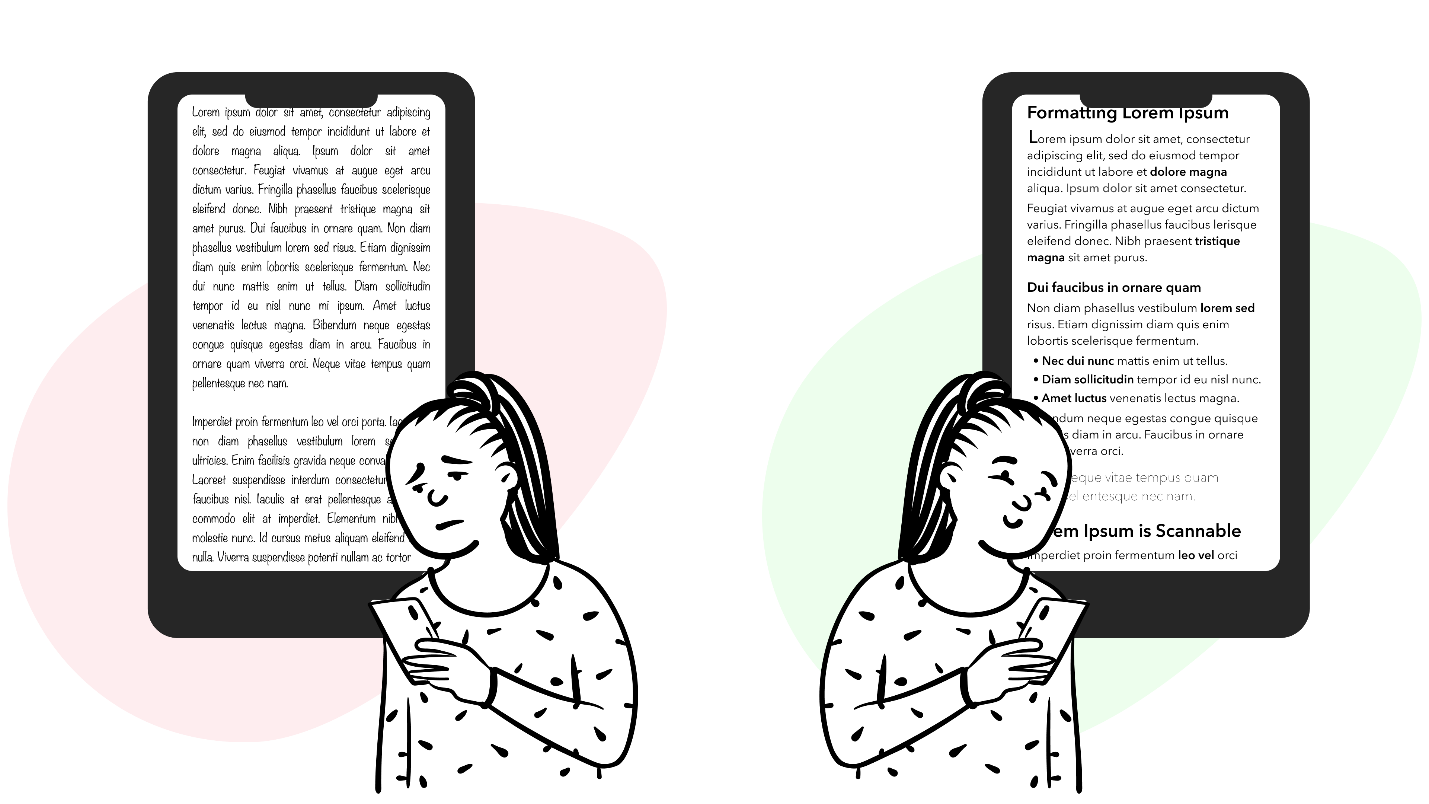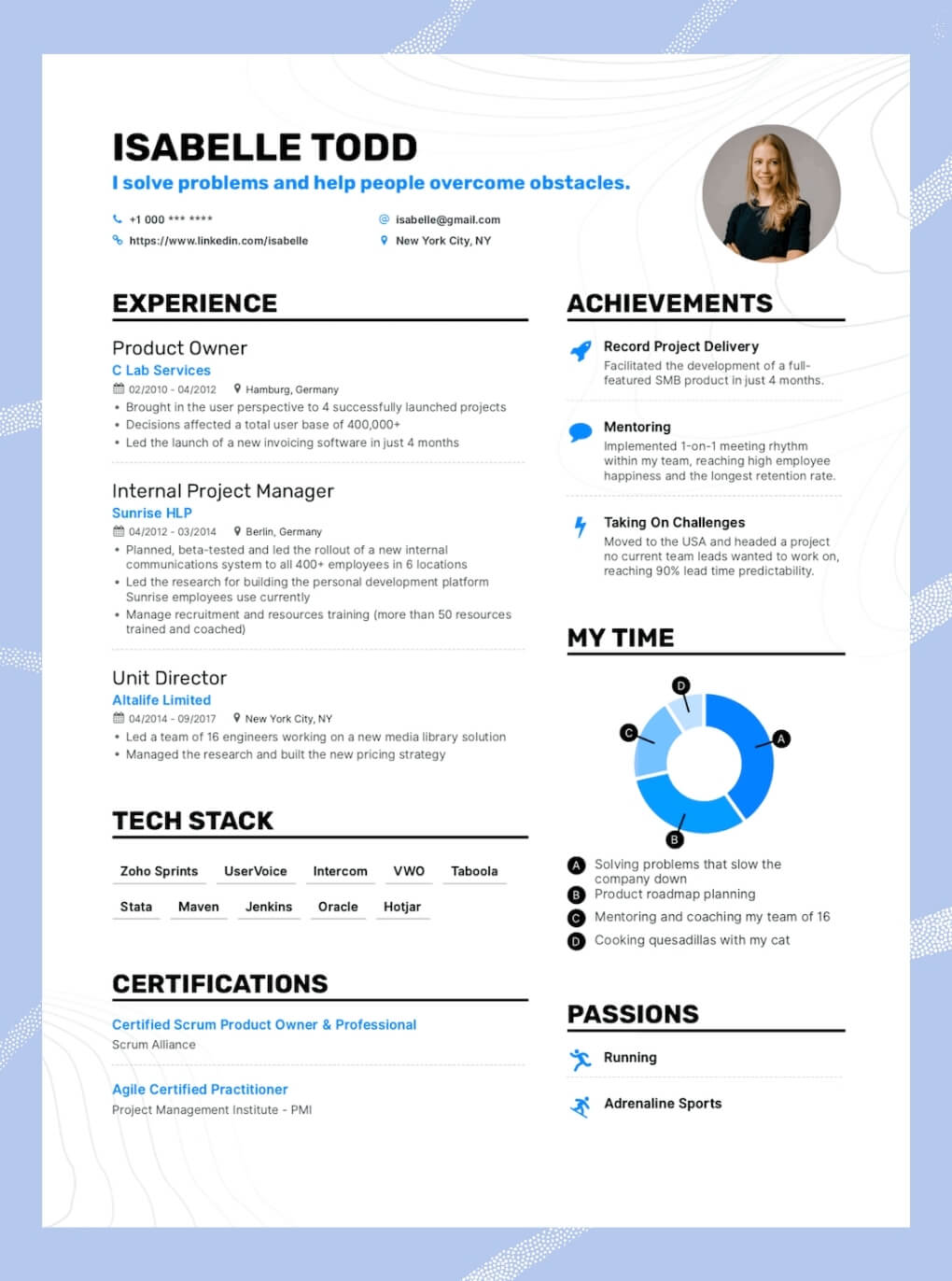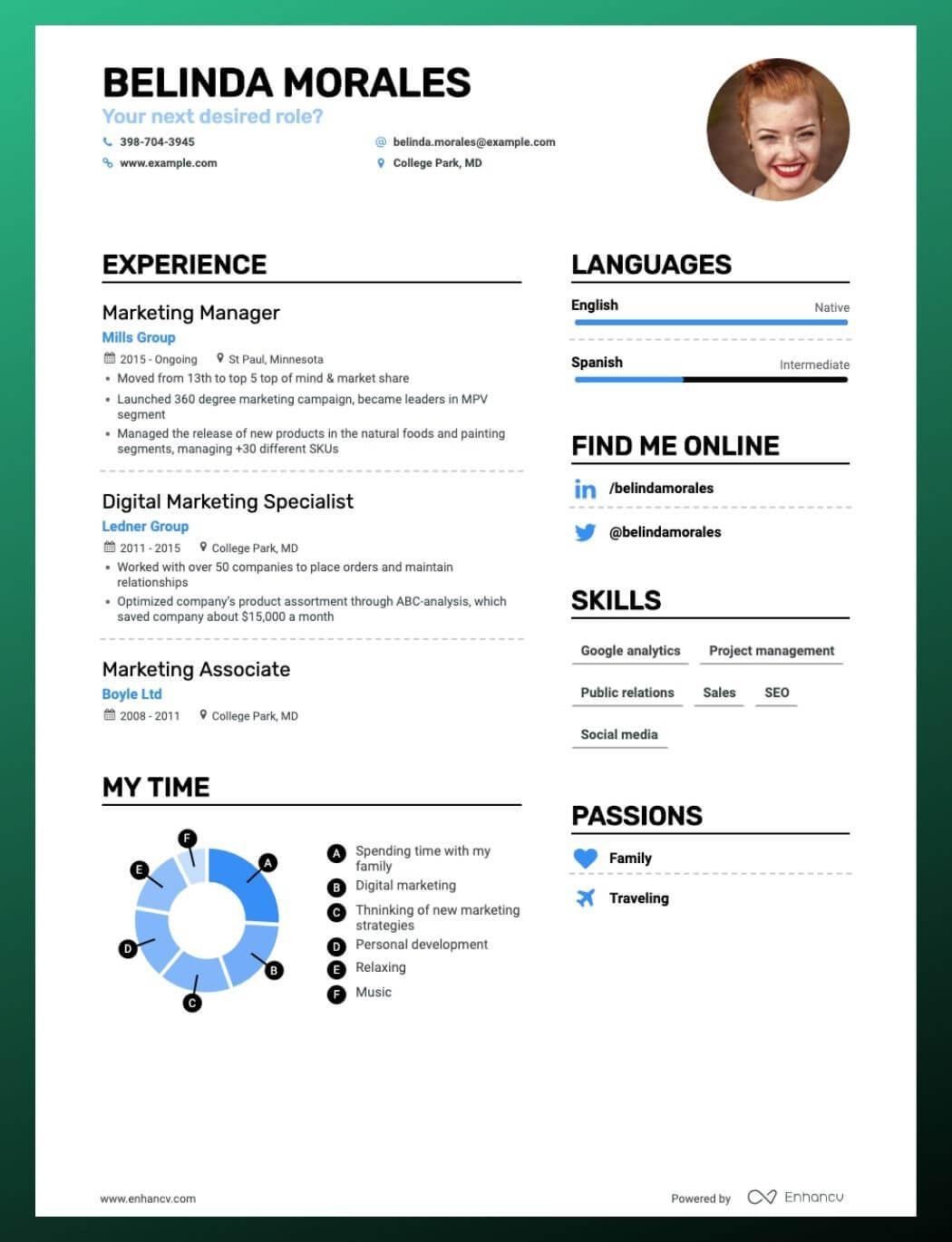For many job seekers, the greatest challenge is putting together the parts of a resume that will help them get the interview.
Whether you are just starting your career or already have 15 years of experience, resumes are never easy to write.
What makes this task particularly testing is the fact that most recruiters spend only about six seconds scanning through each resume they receive.
Only six seconds…
This is less than the attention of a goldfish.
With that in mind, you are probably asking yourself how to create a resume that stands out, and what parts should my resume include?
Don’t worry. We are here to help!
In this guide, you’ll learn:
- How to grab the attention of the recruiters using the proper key resume elements
- How to choose the most important resume components
- How to take your resume to the next level by implementing Bonus Resume Elements
- How to turn the design of your resume into a real masterpiece
Looking for a specific work resume guide? Check out our examples!
3 key elements of a resume
Whether you are writing a Professional Python Developer Resume or a Teacher Resume there are some must-do resume components that you just can’t miss.
From the main parts – the resume header, career summary, and skills, and expertise to secondary sections like your volunteering experience and award certification, everything is valuable and can catch the attention of the recruiter.
Moreover, you can include some design elements like text boxes, charts, and graphs that will make your resume stand out from the majority of documents!
Sounds overwhelming?
It’s not.
Let’s jump to the main sections and you’ll start to feel way more comfortable preparing your resume.
1. Basic Parts of a Resume: Main Sections
Depending on the position you are applying for as well as your career and education level, sections may vary.
Although there are a lot of resume sections, the following five are the most important and requisite.
- Resume Header
- Career Summary or Objectives
- Work Experience / History
- Education
- Skills and Expertise
Resume header & contact section
According to a recent study, the name of the applicant is the first item that most recruiters are searching for when reviewing a resume. Moreover, if your name isn’t easily found, recruiters will probably discard your resume.
Besides that, many organizations rely on automated tracking systems (ATS) that use your resume header to figure out the structure you’re using.
With that in mind, you are probably wondering how to create a header that appeals to both recruiters and ATS systems?
It’s not so hard at all.
Below you can find a good and a bad example from our Business Analyst Resume Guide:

As you can see, customizing your email, job title, and your LinkedIn URL will help your header stand out from the competition.
After you have the attention of the recruiter it’s time to move on to the experience section!
Resume experience section
The experience section is as important as the header of your resume.
Why?
Because in this part of the resume, you’ll build credibility, proof and showmanship of the required skills and expertise.
Moreover, employers will be able to identify if you’re a candidate who understands what needs to be done and can handle the job responsibilities and tasks.
Besides that, by properly filling in your details, recruiters will know if you can start the desired job immediately or you will need some additional training.
To learn more about different types of formats, which keywords and buzzwords to include, and 5 proven examples with Enhancv that got candidates hired, check our detailed Work Experience Resume Guide!
Resume education section
Steve Jobs, Bill Gates, and Mark Zuckerberg are inspiring entrepreneurs who dropped out of school and went on to become billionaires.
The idea that you don’t always need a degree to succeed in life might be interesting to entertain.
The reality?
Education is still one of the top hiring factors in the majority of industries nowadays.
Not convinced?
Here are 5 reasons why education will always be essential for your resume:
- It serves as proof of competence
- It explains the gaps in your past experience
- It increases job relevance
- It highlights your hard work and long term investment in your career
- It doesn’t hurt your chances
Just keep in mind that the education section is one of those parts of a resume that can assure the recruiters you are the right person for the job!
Resume skills section
One of the most common mistakes is a lack of knowledge of what to include in this part of the resume. Applicants usually think having more skills is better and try to include as many as they can.
What you really need to do?
Take a look at what skills the company needs by taking note of the job description. Then identify your strengths and create a list of the skills that are essential for a particular job.
To be more specific, check our Marketing Manager Resume Example below:
As you can see, all of the listed skills are highly relevant to the job of a Marketing Manager. Google Analytics, Project management, Public relations, sales, SEO, and Social media are all parts of the marketing mix that every digital marketer should possess.
Check 9 more great examples of Resume Skills Sections that can impress the recruiters.
Targeting your resume with the right keywords
Tailoring your resume to the specific job significantly improves your chances to land a job interview.
But how to quickly and effectively adjust your resume?
Follow our 3-step process that will help you study job descriptions and easily build resume relevancy:
- Research target company
- Learn more about the company you’re applying for and its other departments.
- Research the tone that the company uses in its listings.
- Think about how recruiters see their ideal applicant for the position.
- Make a mental note of what you can improve in your resume to fill the ideal candidate profile.
- Tailor Experience section
- Identify keywords in the job description that will boost the relevancy of your resume
- Study the job description to understand how to properly frame your past experience
- Create workflows that include keywords from the job description and follow the impact formula
- Get Your Target Resume To Perfection
- Change custom headline at the top
- Restructure resume layout to put the most critical sections for the job upfront
- Change the color theme and use bold font to emphasize critical points for the recruiters
2. Bonus resume elements: Take it to next level
These parts of the resume should bring your application to the next level.
Each of the bonus elements’ missions is to reinforce the main resume components and add some extra value.
What will you learn here?
- How to make strong resume summary and resume objective sections
- When to include language skills and the most effective ways to do it
- Enhancv staples to make a truly personal resume
Resume summary and resume objective
First of all, what is the goal of your resume summary?
Outlining all of your most important and relevant experience, accomplishments, and knowledge into just a few sentences.
Why do you need it?
Because you’re giving the recruiter a brief on what you can potentially do for their business.
Is it necessary?
Not at all.
What matters the most is how it’s going to be used to increase your chances of getting an interview.
Recommended read Resume Summary: How-To Guide (30+ Examples You Need To See)
Another optional element is the Resume Objective.
A resume objective is a statement no more than 3 sentences long which summarizes what are your career goals through employment.
It can be used if you don’t have a long-term working history to write about and you prefer revealing what you’re looking to accomplish in the future.
Learn more about the Pros and Cons of Using a Resume Objective in our detailed guide!
Resume language skills
You are probably asking yourself – Do recruiters care about my language skills?
Of course, they do!
Language skills not only give you the ability to communicate with colleagues and clients, but it also comes with culture-specific knowledge, too.
Okay, but when to use this part of the resume?
- If speaking a foreign language is useful for the company
- If you lack job experience
- If the required position is highly competitive
- If you’re applying for a job in another country
- If you have to demonstrate quick-learning skills
Want to learn when not to include your resume language skills?
Additional Sections (They’ll give you that culture-fit nudge)
Additional sections’ purpose is to supplement the main resume parts.
As we mentioned, you can include them if you don’t have enough working experience.
Check some of our staples to make a truly personal resume:
- My Time
- Volunteering
- Projects
- Social Links
- References
Learn more about each of the additional resume elements in our detailed guide.
3. Resume design elements that are essential
Last but not least, we will speak about the design elements of your resume.
By implementing them your resume will look way more appealing to recruiters.
A well-designed resume, with easily scannable text, enough white space, text boxes, charts, graphs, and captivating font will surely enhance the chances of getting the desired position!
Make your resume scannable
First of all, what does it mean that the resume is scannable?
Scannable content is the one that can easily be skimmed.
In other words, you can go through the text without feeling that you are facing a wall of text.

Don't forget about white space.
White space can be defined as a break in the copy.
Why is it important?
Because it helps the readers better comprehend what you’re trying to say.
Moreover, they can skim subheadings, bulleted lists, and other elements designed to help communicate information in a clear and concise way.
Draw attention with text boxes, charts, and graphs
According to several studies, visuals are the first components that visitors see on the website.
This also applies to resumes.
You can catch the eye of the recruiter with beautiful graphs and charts full of valuable information about you and your experience.
Check Isabelle’s resume below:

The pie chart grabbed your attention, right?
That’s what we are talking about.
Have fun with fonts and font styles
Another way to make a great first impression is by using the right fonts for your resume.
Is the font so important?
Yes!
Good text layout will guide the recruiter through your summary and make sure they will read it to the end.
Also, the font styles are recognized by ATS (automated tracking systems). The software used by the recruiters to preliminary screen your resume before it comes to their desk.
Find out more about the art of using the right resume font along with the 5 best fonts you should use in our detailed article!
Conclusion
Now you learned about all the main, secondary, and optional parts of the resume. With this arsenal of knowledge, you can structure an appealing job summary that can score you an interview.
You have the recipe for a job-winning resume and all the right ingredients. Get cooking!
Find your profession between 530+ Resume Examples and Samples!
And don’t forget.
We are always here to help!
***
Did you like this guide? Do you have any experience building a resume with specific sections? Share it in the comments below.
Make one that's truly you.




